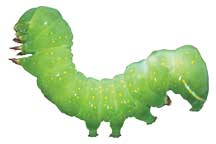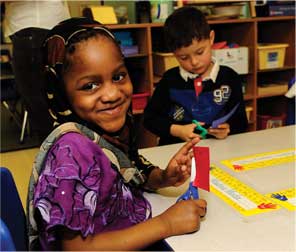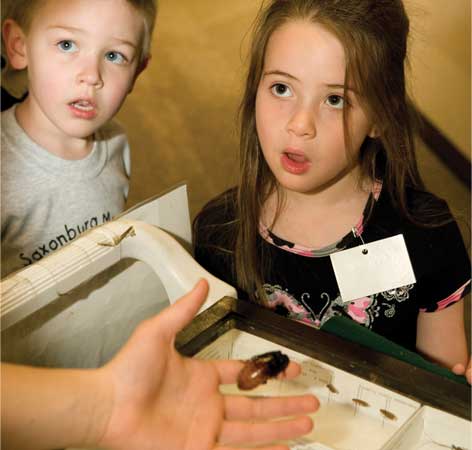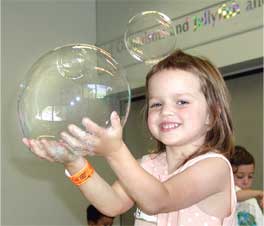Summer 2010
 |
||
| Wendy Brenneman, Carnegie Science Center’s early childhood coordinator, sparks preschoolers’ curiosity about animal camouflage. |
 Growing Up With Science Growing Up With ScienceA five-year-old program to get preschoolers excited about science has earned the Science Center accolades from teachers, parents, and the PNC Foundation, which is using it as the model for its $6 million Grow Up Great with Science initiative. The Carnegie Science Center educator moves the image from child to child, looking for someone who can spot the well-disguised camouflaged fish. She finds her heroine in 5-year-old Korren, who triumphantly announces, “My eyes can see him!” After a few more practice rounds with picture books, the children return to their desks to cut butterflies from yellow, red, and blue construction paper. Then, at Brenneman’s prompting, half of the kids in the group hide their butterflies against similarly-colored backgrounds throughout the classroom, allowing their classmates to find them if their eyes are sharp enough.  Ibrahim, 5, discovers a blue butterfly taped to the blue background of his classroom’s Alphabet Center. Running with the idea, he then places his own butterfly on a blue chair, where it’s spotted by his 4-year-old classmate, Aniyah. “I found it!” she exclaims. Without realizing it, the youngsters are learning the basic science of animal camouflage from a simple game of hide-and-seek. It’s just one of many creative learning experiences concocted by Science Center educators as part of the Grow Up Great with Science program—a mix of tools, lessons, and plenty of fun to help educators and parents nurture the natural scientific curiosity that all children that age possess. “At the preschool level, there is already a natural curiosity, and there are no preconceived notions about science,” says Ann Metzger, the Henry Buhl, Jr. co-director of Carnegie Science Center. “This program is simply about getting young kids excited about the world around them.” “The whole idea of exploration became part of the math lesson, became part of the art lesson. It really infused the whole day.”- Eva Blum, president of the PNC foundationTo help create that excitement, five years ago Science Center educators developed some simple tools for the parents and educators of preschoolers in conjunction with PNC Grow Up Great, a 10-year, $100 million early-childhood education initiative funded by the PNC Foundation. Outreach to pre-schools began primarily through a handful of Head Start classrooms. The goal was simple: to give adults help in lighting that ever-important spark of curiosity among young children—specifically, a curiosity for science. photo: Tom Altany The response among parents and educators was overwhelmingly positive, which prompted PNC to expand the effort and use the Science Center’s initiative as the pilot of a $6 million Grow Up Great with Science program that’s all about fostering a foundation in science among preschoolers. Last year, the PNC Foundation announced that Carnegie Science Center would be one of 14 organizations in seven states and the District of Columbia to receive funding as part of the new science initiative. Already, Carnegie Science Center’s Grow Up Great with Science programming has reached some 2,600 preschoolers in 133 Head Start classrooms in the Pittsburgh Public Schools and Westmoreland County. Early interventionAngela Shaw of New Kensington notices a marked difference in the curiosity level of her 4-year-old son, Ryan, who participates in these science lessons through his Head Start classroom.“He’s so interested in learning new things,” says Shaw. “He tries telling me what they do in class … he’ll point things out and show me.” Like on their walk to school, she says, Ryan picks up leaves and collects bugs in an old lunch box. “He’ll say, ‘Look at this leaf, it has a hole in it.’ Then he’ll ask, ‘I wonder what was eating it?’”  Shaw says she’s also encouraging her son’s learning by occasionally copying one of the science projects at home. For instance, she recently buried small toys in gelatin and let Ryan remove them, as if he was digging for scientific treasure. She also lets him practice kitchen chemistry. “He always wants to help me in the kitchen, measuring,” Shaw says, laughing. “I’ll deal with the mess.” Ron Baillie, co-director of the Science Center, says that type of inquiry is exactly what Grow Up Great with Science is trying to cultivate. “For a long time, we thought it was early enough to work with kids by middle school,” says Baillie, a veteran educator. “But over time, educators realized that we need to reach out to children much earlier, because by middle school kids have already formed some very clear perceptions and attitudes about math and science.” Once children are reluctant to embrace certain subjects, he adds, a door could be closed forever. Baillie adds that, by middle school, kids have to start making decisions about whether they’ll take more classes in math and science. “If they decide not to take those classes, they’re already creating barriers to future career options,” he says. And the kids aren’t the only losers in that situation; the labor market suffers as well. Ever the advocates of science literacy, the staff at the Science Center regularly remind their regional audiences that Pittsburgh currently lacks enough labor skilled in math, science, and technology—a deficit that will only widen over time. Reversing the trendBefore the Science Center developed its programming, it surveyed preschool teachers to gauge their confidence in teaching science concepts. Not surprisingly, the results showed that confidence was low.“Teachers made comments like ‘I never liked science in school’ or ‘math and science aren’t my strong suit,’” says Baillie. While not unexpected, those findings were alarming, especially considering what the educational community has learned about the importance of early childhood development. “Those first five years of life are so important in a child’s development,” says Eva Blum, president of the PNC Foundation. “To the extent that they are stimulated, their brains become more highly developed.”  More than 2,600 preschoolers from 133 Head Start programs have already had their eyes opened to science through the Science Center initiative. More than 2,600 preschoolers from 133 Head Start programs have already had their eyes opened to science through the Science Center initiative. The Science Center quickly determined that the best way to stimulate those young brains is to give their educators the tools—and the comfort level—to make science an everyday part of early learning. Before the PNC Foundation (which receives its principal funding from the PNC Financial Services Group) considered extending its funding, PNC and Head Start independently evaluated the effectiveness of preschools that had benefited from Science Center programming. What they found, Blum notes, was a group of teachers better-equipped and more enthusiastic. “The results were very promising,” says Blum. “Those teachers gained confidence in their ability to teach science, and they learned to make use of free and low-cost resources and where to find them.” Once familiar with the scientific method, educators found new ways to practice their knowledge. “The whole idea of exploration became part of the math lesson, became part of the art lesson. It really infused the whole day.” PNC’s independent study also revealed that learning among students in participating Head Start programs was equivalent to that of students in a highly regarded private preschool. These results not only helped the Science Center win the Grow Up Great funding, but it also inspired PNC to model the entire program after Carnegie Science Center’s example. Bugs and BubblesRachel Marinchek’s 3-year-old daughter, Rachelle, loves the hands-on activities in her classroom at Derry-Latrobe Head Start in Westmoreland County.“Right now, they have magnifying glasses out, and the kids love that,” says Marinchek, who also serves as a classroom aide. “They run around the room magnifying everything.” Wendy Brenneman is the Science Center’s early childhood coordinator who has modeled lessons at most of the 133 Head Start classrooms now participating in the Grow Up Great with Science program. She agrees that preschoolers are eager to learn about science, though they may not always have had the opportunity to do so—especially kids in urban and rural classrooms. “Really, it’s one of the most fun and easiest subjects to teach, because it starts with the question ‘why’ and then moves on to exploring the reasons,” says Brenneman. “We wanted to work with urban and rural classrooms because they tend to be underserved in science. The support system may not necessarily be there, especially in available classroom materials. It’s not that the teachers don’t want to teach the science, but it can be a scary subject when you’re looking at it from the outside.” Rhiannon Hindman, who teaches preschool at Arsenal Elementary, agrees. “Science is tricky,” she says. “It’s not something I always include; it’s nice seeing firsthand what Science Center educators do. Sometimes, you just need ideas.” In developing programs, Brenneman says the staff tries to hit on topics that are sure to capture the children’s attention. Bubble Science is a favorite because, as Brenneman asks, “Really, who doesn’t love bubbles?” As the children blow bubbles, they’re asked what’s inside, how it got there, and how they can make their bubble bigger. “Something simple but fun, kids are always going to gravitate towards,” explains Brenneman. “That, and bugs, of course. “I had some feedback from a teacher who said they were having circle time in their classroom, and the kids noticed an ant on the floor. So they spent 20 minutes chasing the ant around with a magnifying glass. That’s exactly what we want to see: the curiosity, the inquiry, and exploring things to see how they work.” In addition to a one-day training for teachers and two classroom visits from Science Center educators per year, each participating classroom receives two science toolkits filled to the brim with basic science tools: magnifying glasses, bug boxes, mini shovels, and the like, as well as a book of activities to help teachers lead students on science explorations. The Science Center also hosts a family night, usually at a nearby school, so that the preschoolers, their parents, and siblings can experiment together at different hands-on science stations. Each participating child also receives a pass admitting four people to Carnegie Science Center for a day of science-filled fun. Blum credits the Science Center with creating a successful model that led the way for Grow Up Great’s expansion. “Carnegie Science Center really had the vision to work with Head Start from the beginning and make this program come alive,” she says. “In a way, they taught us the potential of what this program could mean for young children, particularly disadvantaged young children.” |
|
Also in this issue:
The Disappeared · Ode to a Collection · Twisted Pair · Special Supplement: A Tribute to Our Donors · Directors' Note · NewsWorthy · Face Time: Zhe-Xi Luo · Artistic License: Domestic Explorations · Science & Nature: Geological Wonder · About Town: Artists Among Us · The Big Picture
 |
Copyright © 2017 CARNEGIE Magazine. All rights reserved. |
